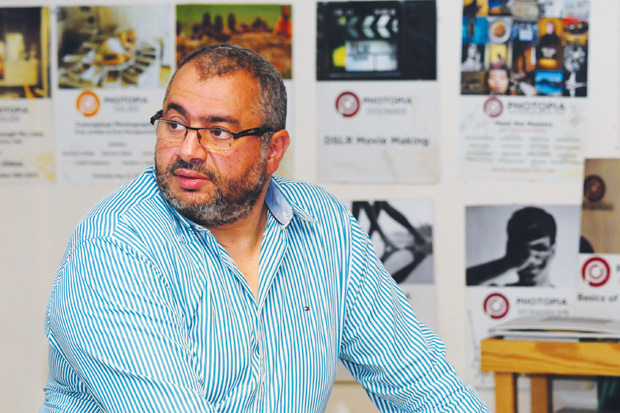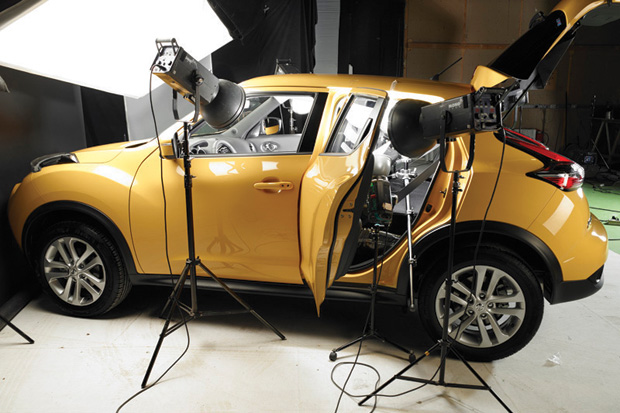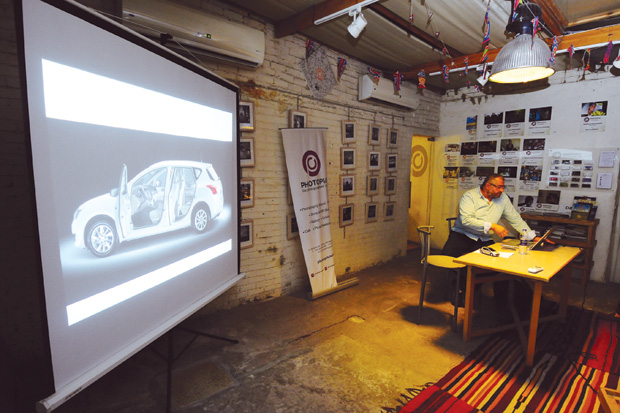Khaled El Dash has been in the photography industry for more than 24 years. In a session held at Photopia, heralded by enthusiasts as “the photographers’ hub,” last month, El Dash talked about his interest and passion in car photography.
By Farah El Akkad
Photos courtesy of Khaled El Dash
“My interest in photography goes way back to when I bought my first camera. I was in third prep,” El Dash recalls. As an applied arts student majoring in photography, El Dash had a special interest in product shots and indoor photography inside studios. Throughout his college years and after graduation, El Dash focused his career on photographing different products such as furniture and working on soft drinks campaigns. El Dash worked as an independent photographer after graduating in 1991 and also as an assistant to many foreign photographers before opening his own studio in 1998.
[caption id="attachment_358709" align="alignnone" width="620"] El Dash, auto art specialist, says he never tires or gets bored of car photography "because every car has its own shape and design."[/caption]
El Dash, auto art specialist, says he never tires or gets bored of car photography "because every car has its own shape and design."[/caption]
In 2001, El Dash’s career took a new turn when he decided to set up Gearbox Studios with co-founder and friend Ahmed Zidan. “We established one of the biggest studios in Egypt and the Middle East, equipped with high technology, flashes and digital packs. Our message is that photography is an industry just like the cinema industry, an industry that has its own value and one that should be done professionally.”
In 2002, El Dash and Zidan decided to specialize in car photography in addition to other products. “It was the first of its kind in Egypt, to photograph a car inside a studio,” says El Dash. “We did our research and traveled to Germany to bring in the special equipment needed. It was extraordinary to see the size of the industry and the technical and very precise equipment used. Car photography became one of our main niches besides furniture and other products.”
As much as El Dash enjoys his job as a car photographer, he explains that the hardest part of it is that the photographer has to fall in love with the car and bring out the best of its design — at the same time he must not leave anything out. “Photographing is actually the easiest part of the job; preparation is the hardest part,” says El Dash who explains that it may take anything from hours to days. “The photographer needs to drink in the design of the car, both the interior and exterior design, look at it from different angles and try different lighting techniques. Then, after a lot of work, you decide what is the best way to do it.”
[caption id="attachment_358711" align="alignnone" width="620"] Auto art specialist El Dash says CGI can never be a substitute for real photography.[/caption]
Auto art specialist El Dash says CGI can never be a substitute for real photography.[/caption]
Different photography techniques mainly depend on clients who usually ask for a specific impression they want their customers to receive from the image they see in an ad, says El Dash, who concedes he works according to the client’s perspective. “For example, some companies want their car to look powerful or aggressive.
Others want to stress on the car’s height or size. Then we add our artistic input. People who look at car ads in magazines or on billboards have no idea what photographers go through to bring out all the details and lines of the car design.
El Dash explains that something as big as a car cannot be easily controlled and the main challenge most car photographers face is bringing out the beauty of a car’s lines and glow. “It’s just like photographing a bride and groom. I look at cars in the same way; the goal is to make it look like the most beautiful car in the world.”
The auto art specialist says he never tires or gets bored of car photography “because every car has its own shape and design and there is always something new to look forward to, particularly if you have a passion for cars.” That said, El Dash believes that car photography in studios is dying out worldwide because most companies are now switching to computer generated imagery (CGI). “It is a much more developed technique most studios abroad now use. It is less costly and, more importantly, saves a lot of time and energy,” he explains. But to El Dash CGI can never be a substitute for real photography.
“In order to be able to use CGI, a photographer must gain experience in reality because then he’ll be able to know how to use light, even if it is while sitting behind a computer’s screen,” El Dash says, stressing that photography is not only a huge industry in itself; it also plays a role in other industries in Egypt — one that completes and helps convey and deliver the message of any product — and as such should not be taken lightly.
[caption id="attachment_358710" align="alignnone" width="620"] El Dash at Photopia.[/caption]
El Dash at Photopia.[/caption]
The Photographers’ Hub
Established in 2012, Photopia is a platform for photographers and anything related to the art of photography. Photopia founder Marwa Abu Leila says she decided to start the project after realizing that “many photographers in Egypt are not catered to and are not receiving any help professionally, particularly in the field of commercial photography. The artistic part was well covered by clubs and schools. We wanted to focus more on celebrity photographers such as Khaled El Dash, Ayman Abbas, Tawfik Araman. We wanted to do the bridging between small photographers who cannot reach celebrity photographers.”
Photopia is also a gallery, a studio for rent and school photography that teaches basic photography techniques and other more specialized photography classes. The space hosts talks, sessions and workshops, competitions, and critique nights, and Abu Leila says, “You do not need to be a pro to come to Photopia. You can just be someone who is interested in photography.”
Comments
Leave a Comment